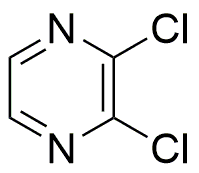2,3-Dichloropyrazine is widely utilized in research focused on:
- Agricultural Chemicals: This compound serves as an important intermediate in the synthesis of various agrochemicals, including herbicides and fungicides, helping to improve crop yields and protect against pests.
- Pharmaceutical Development: It is used in the development of pharmaceuticals, particularly in creating compounds that target specific diseases, enhancing the effectiveness of medications.
- Material Science: The compound is utilized in the formulation of advanced materials, including polymers and coatings, which offer improved durability and resistance to environmental factors.
- Flavor and Fragrance Industry: 2,3-Dichloropyrazine is employed in the synthesis of flavoring agents, contributing to the development of unique tastes and aromas in food products.
- Research Applications: It is a valuable reagent in organic synthesis and analytical chemistry, aiding researchers in various experimental setups and studies due to its reactivity and versatility.
General Information
Properties
Safety and Regulations
Applications
2,3-Dichloropyrazine is widely utilized in research focused on:
- Agricultural Chemicals: This compound serves as an important intermediate in the synthesis of various agrochemicals, including herbicides and fungicides, helping to improve crop yields and protect against pests.
- Pharmaceutical Development: It is used in the development of pharmaceuticals, particularly in creating compounds that target specific diseases, enhancing the effectiveness of medications.
- Material Science: The compound is utilized in the formulation of advanced materials, including polymers and coatings, which offer improved durability and resistance to environmental factors.
- Flavor and Fragrance Industry: 2,3-Dichloropyrazine is employed in the synthesis of flavoring agents, contributing to the development of unique tastes and aromas in food products.
- Research Applications: It is a valuable reagent in organic synthesis and analytical chemistry, aiding researchers in various experimental setups and studies due to its reactivity and versatility.
Documents
Safety Data Sheets (SDS)
The SDS provides comprehensive safety information on handling, storage, and disposal of the product.
Product Specification (PS)
The PS provides a comprehensive breakdown of the product’s properties, including chemical composition, physical state, purity, and storage requirements. It also details acceptable quality ranges and the product's intended applications.
Certificates of Analysis (COA)
Search for Certificates of Analysis (COA) by entering the products Lot Number. Lot and Batch Numbers can be found on a product’s label following the words ‘Lot’ or ‘Batch’.
*Catalog Number
*Lot Number
Certificates Of Origin (COO)
This COO confirms the country where the product was manufactured, and also details the materials and components used in it and whether it is derived from natural, synthetic, or other specific sources. This certificate may be required for customs, trade, and regulatory compliance.
*Catalog Number
*Lot Number
Safety Data Sheets (SDS)
The SDS provides comprehensive safety information on handling, storage, and disposal of the product.
DownloadProduct Specification (PS)
The PS provides a comprehensive breakdown of the product’s properties, including chemical composition, physical state, purity, and storage requirements. It also details acceptable quality ranges and the product's intended applications.
DownloadCertificates of Analysis (COA)
Search for Certificates of Analysis (COA) by entering the products Lot Number. Lot and Batch Numbers can be found on a product’s label following the words ‘Lot’ or ‘Batch’.
*Catalog Number
*Lot Number
Certificates Of Origin (COO)
This COO confirms the country where the product was manufactured, and also details the materials and components used in it and whether it is derived from natural, synthetic, or other specific sources. This certificate may be required for customs, trade, and regulatory compliance.


